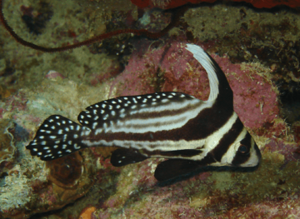Spotted drum facts for kids
The spotted drum or spotted ribbonfish (Eques punctatus) is a type of ray-finned fish that lives in the ocean. It belongs to a group of fish called Sciaenidae, which are known as drums and croakers. You can find this fish in the western Atlantic Ocean.
Quick facts for kids Spotted drum |
|
|---|---|
 |
|
| adult | |
 |
|
| juvenile | |
| Conservation status | |
| Scientific classification | |
| Synonyms | |
|
Contents
What Does the Spotted Drum Look Like?
The spotted drum has a body shape that is longer than it is wide. It is deep near its head and gets thinner towards its tail. Its head is low, and its snout sticks out a bit over its small mouth.
This fish has two dorsal fins (fins on its back). The first one is tall and spiky, with 12 to 14 sharp spines. The second dorsal fin is longer and has one spine and 45 to 47 soft rays. Its anal fin (fin on its belly) has 2 spines and 8 soft rays.
The spotted drum's body is covered in special scales called ctenoid scales. A line of scales called the lateral line runs along its side all the way to the middle of its caudal fin (tail fin).
The tail, anal, and soft-rayed parts of the dorsal fins are dark with white spots. The head and the spiky dorsal fin have vertical white and dark brown stripes. These stripes curve to form long lines along the body.
Young spotted drums look different! They have a white body with three black stripes. The stripe furthest back goes through the dorsal fin and onto the tail fin. They also have a black oval spot on their snout and a black stripe on their pectoral fin (fin near its gills).
This fish can grow up to about 27 centimeters (10.6 inches) long, but most are around 18 centimeters (7 inches).
Where Does the Spotted Drum Live?
The spotted drum lives in the western part of the Atlantic Ocean. You can find it in places like the Bahamas, the Gulf of Mexico (near the Florida Keys and parts of Mexico like Tuxpan and the Yucatan), and throughout the Caribbean Sea.
This fish usually lives in water that is between 3 and 30 meters (10 to 98 feet) deep. It likes to live near coral reefs, which are like underwater cities made of coral.
How Does the Spotted Drum Live?
During the day, spotted drums are often seen hiding under ledges or near the entrance of small caves. They swim in the same patterns over and over again.
They are active at night, which means they are nocturnal. When it gets dark, they leave their hiding spots to find food. They mainly eat small crustaceans, like tiny crabs or shrimp, and Polychaete worms, which are a type of sea worm.
Why is the Spotted Drum Important?
The spotted drum is a popular fish for people who have aquariums. Its unique look and interesting behavior make it a favorite for fish tanks.


